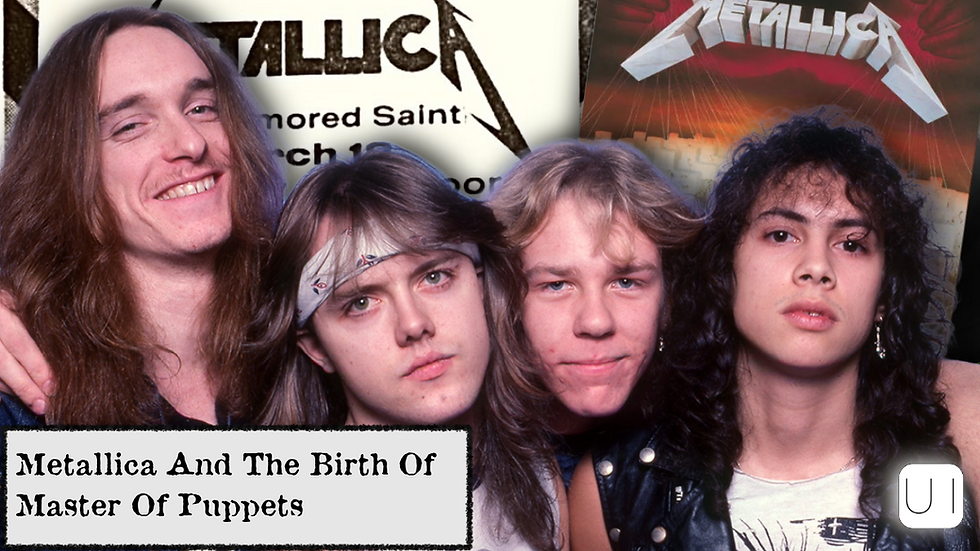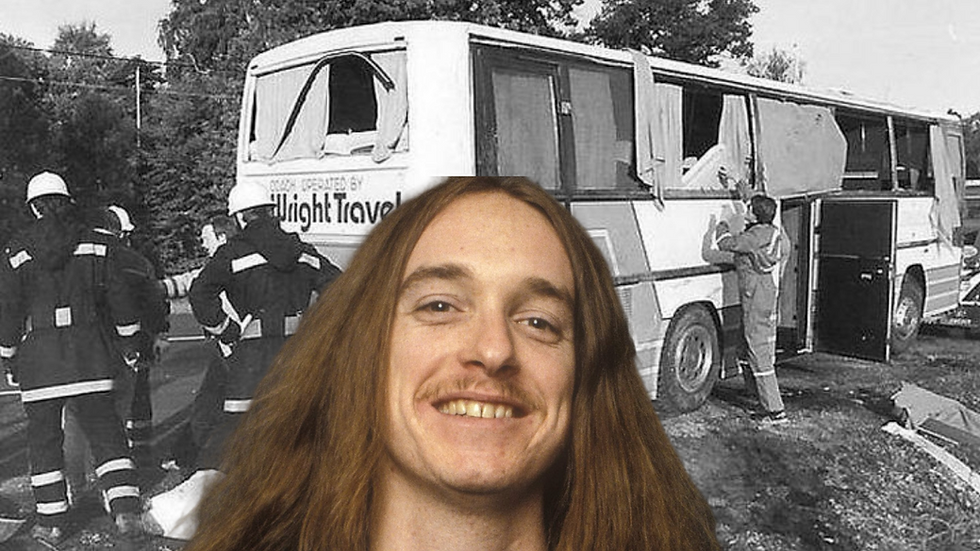Master of Puppets: The Story Behind Metallica’s Thrash Metal Masterpiece
- Daniel Holland

- Mar 3, 2021
- 7 min read

By 1985, Metallica had already carved out a name for themselves as the most ambitious of the Bay Area thrash bands. They’d created a blueprint on Ride the Lightning, and now all they needed was to build upon it, with longer songs, sharper riffs, and the kind of unrelenting fury that could carry them to the next level. That blueprint became Master of Puppets, released on March 3, 1986, an album that would redefine metal forever.
Writing the Album
Work began in mid-1985, just as Metallica were riding the momentum of a successful album and world tour. They had the confidence of a world-class athlete before a big game, but writing wasn’t easy. In the span of just six to eight weeks, however, they managed to create some of the most intricate, multi-layered songs of their career.
Today, Master of Puppets is remembered as the record that pushed thrash metal into the mainstream. Songs like “Battery,” “Disposable Heroes,” and “Damage, Inc.” were pugnacious bursts of speed, while “Master of Puppets” and “Welcome Home (Sanitarium)” delivered rhythmically complex epics. Elsewhere, “The Thing That Should Not Be” and “Leper Messiah” offered crushing mid-tempo riffs, and the instrumental “Orion” brought cinematic scope to thrash.
Understanding how they achieved such balance requires looking back at Ride the Lightning. More than a bridge between Kill ’Em All and Master of Puppets, it had given Metallica the courage to bend rules. Both albums shared a similar architecture: clean guitar intros exploding into thrash, sprawling tempo shifts, ominous slow numbers, and ambitious instrumentals that separated Metallica from every other band on the scene.
By the time writing started, Metallica already knew what they wanted: a better, heavier, and more ambitious version of Ride the Lightning.
“We more or less wanted to redo Ride the Lightning, just a lot better,” producer Flemming Rasmussen later told Rolling Stone. “I’ve always thought Metallica raised the bar every time they went in the studio. They challenged their own technical ability all the time, which is the only way you can get better.”
That meant practice. Lars Ulrich took drum lessons to improve his timing, while Kirk Hammett reconnected with his old teacher, Joe Satriani, for extra pointers. At their shared house in El Cerrito, California, Hetfield and Ulrich began writing. The first song finished was “Battery,” quickly followed by “Disposable Heroes.”
“That song has some of my favourite lyrics that James has written,” Ulrich said. “He nailed the whole wasted irrelevance of a soldier going off to war and life playing out before his birth. Musically, it’s got a lot of classic Metallica elements: fast parts, mid-tempo verses, halftime things and a lot of interesting progressive stuff that weaves itself in and out of the whole middle section.”
Lyrics of Control and Corruption
Lyrically, Master of Puppets marked a step forward from the straightforward aggression of earlier songs like “Hit the Lights” or “Metal Militia.” Themes of control, manipulation, and corruption ran throughout the album.
“Welcome Home (Sanitarium)” was inspired by Ken Kesey’s One Flew Over the Cuckoo’s Nest, a haunting take on mental imprisonment.
“The Thing That Should Not Be” drew on H. P. Lovecraft, feeding Metallica’s ongoing fascination with horror and mythology.
“Leper Messiah” took aim at televangelists, exposing the hypocrisy of those exploiting faith for money.
The title track tackled drug addiction with some of Hetfield’s sharpest lines:
“Pain, monopoly / Ritual misery / Chop your breakfast on a mirror.”
“I just went to this party in San Francisco and there was a bunch of sick freaks shooting up, and it made me sick,” Hetfield later explained. “It’s not about any drug in general but people being controlled by drugs and not the other way around.”
Recording in Copenhagen
Metallica originally wanted Rush’s Geddy Lee to produce, but scheduling made it impossible. Instead, they returned to Flemming Rasmussen, who had guided Ride the Lightning. Ulrich and Rasmussen scouted Los Angeles studios, but couldn’t replicate the drum sound they’d achieved in Copenhagen. So back to Denmark they went, this time booking rooms at the Scandinavia Hotel rather than crashing on Rasmussen’s apartment floor.
At Sweet Silence Studios, sessions ran from September 1 to late December 1985. The band worked nocturnal hours, recording from 7PM until dawn, then heading back to their hotel for breakfast. Before recording their own tracks, they warmed up with covers of Diamond Head’s “The Prince,” The Misfits’ “Green Hell,” and Fang’s “The Money Will Roll Right In.”
Almost immediately, problems arose with Ulrich’s snare drum, which sounded “like a garbage can lid.” Management company QPrime, who also represented Def Leppard, arranged for Rick Allen’s Tama “Black Beauty” snare to be shipped to Copenhagen. By chance, Ulrich also found the exact same model in a local music store at a price unchanged since 1979. Problem solved.
Hetfield’s pursuit of precision became legendary. He recorded at least six rhythm tracks per song, refusing to layer takes, instead playing each part over and over until it was flawless.
“I’m always saying, ‘It’s not tight enough,’” Hetfield confessed in Birth School Metallica Death. “People think I’m nuts. It’s something that absolutely haunts me. After we recorded ‘Hit the Lights,’ this guy told me, ‘Oh, the rhythms aren’t very tight are they?’ Man. That was it! That started my lifelong quest. That was the Holy Grail for me – being tight.”
While Hetfield obsessed in the studio, Burton and Hammett often had little to do.
“We would stay up 24 hours at a time and just go out walking around Copenhagen kind of drunk, doing whatever we could to bide the time,” Hammett recalled to Rolling Stone. “I remember at one point, we found a beach on a map. So we went there but it was so cold and there was absolutely no wave action or anything. Cliff and I were just bundled up on this weird beach in Copenhagen saying, ‘God, this place is driving us crazy!’”
On September 14, they took a break to perform at Germany’s Metal Hammer Festival, debuting “Disposable Heroes.” Over the following months, they finished writing “The Thing That Should Not Be” and “Orion,” the latter becoming Cliff Burton’s masterpiece.
“For me, ‘Orion’ was Cliff Burton’s swan song,” Hammett later said. “It was a great piece of music, and he’d written the whole middle section. It kind of gave us a view into what direction he was heading. If he would have stayed with us, I think he would have gone further into [that] direction. Our sound would be different if he was still here.”
By December 27, 1985, the band left Copenhagen with the tapes in hand. Engineer Michael Wagener mixed the album in Los Angeles.
Release and Reception
Master of Puppets debuted modestly at No. 128 on the Billboard charts, selling 300,000 copies in its first three weeks. It eventually peaked at No. 29, boosted by Metallica’s role as the opening act on Ozzy Osbourne’s U.S. tour.
“[Touring with Ozzy] was a huge break for us,” Ulrich later explained. “At the time, Ozzy was perceived as one of the most controversial metal stars in the US – he drew a really extreme type of crowd… Here we were as this even more extreme up-and-coming metal band that Ozzy was giving his seal of approval to by taking [us] out on tour with him.”
The tour wasn’t without setbacks. On June 26, Hetfield broke his wrist skateboarding. Hammett rang up Anthrax’s Scott Ian to fill in, but Anthrax were about to enter the studio. Instead, Metal Church guitarist John Marshall — Hammett’s tech — stepped in on rhythm duties until Hetfield recovered.
Despite such obstacles, the album stayed on the Billboard charts for 72 weeks. On November 4, 1986, Metallica received their first gold record.
The Loss of Cliff Burton
Tragedy struck on September 27, 1986. While traveling through Sweden, Metallica’s tour bus crashed in Kronoberg County. Cliff Burton, asleep in his bunk, was thrown from the vehicle and crushed. He was just 24 years old.
Burton’s death devastated the band. His funeral was held on October 7, 1986, and after mourning, Metallica chose to carry on. Auditions followed, and by November 8, Jason Newsted had joined as bassist, playing his first show with the band in Reseda, California.
Legacy and Lasting Power
Commercially, Master of Puppets became unstoppable. It went platinum in 1988, double in 1991, triple in 1994, quadruple in 1997, quintuple in 1998, and sextuple by 2003.
For Hammett, the achievement was always about more than numbers:
“I remember holding the album in my hands and thinking, ‘Wow, this is a fucking great album, even if it doesn’t sell anything. It doesn’t matter because it is such a great musical statement that we’ve just created. I really felt that it would pass the test of time. Which it has.”
Even Ulrich, never shy of ambition, reflected proudly:
“If you take the extremes of [the] album, which to my mind would be ‘Damage, Inc.’ and ‘Orion’ – the amount of ground we cover is so big, so vast, it really pisses me off that anybody would want to stick us with one label. Yes, we do a few thrash songs, but that’s not all we like to do.”
Why Master of Puppets Still Matters
Almost four decades later, Master of Puppets remains Metallica’s defining statement. It captured the band at their creative peak, balancing raw thrash aggression with compositional ambition. It pushed heavy metal into the mainstream, earned critical acclaim, and influenced generations of bands.
More importantly, it cemented Metallica as leaders not just of thrash but of heavy music as a whole. Burton’s fingerprints are all over it, Hetfield’s precision haunts it, and the band’s relentless pursuit of “better” drives every note.
Master of Puppets isn’t just an album, it’s a cultural landmark.
Sources
Mick Wall, Enter Night: A Biography of Metallica (2010)
Paul Brannigan & Ian Winwood, Birth School Metallica Death: Volume 1 – The Biography (2013)
Joel McIver, Justice for All: The Truth About Metallica (2004)
Joe Berlinger & Bruce Sinofsky, Metallica: This Monster Lives (2004)
“Metallica’s Masterpiece: How They Made Master of Puppets” – Rolling Stone
https://www.rollingstone.com/music/music-features/metallica-master-of-puppets-making-of-111513/
“Metallica’s Master of Puppets at 30” – Loudwire
https://loudwire.com/metallica-master-of-puppets-anniversary/
“The Making of Master of Puppets” – Guitar World
https://www.guitarworld.com/metallica-master-of-puppets-making
RIAA Platinum Certifications Database – Metallica Master of Puppets
“Cliff Burton: The Lost Legend” – Classic Rock Magazine
https://www.loudersound.com/features/cliff-burton-metallicas-lost-legend










































































































Comments